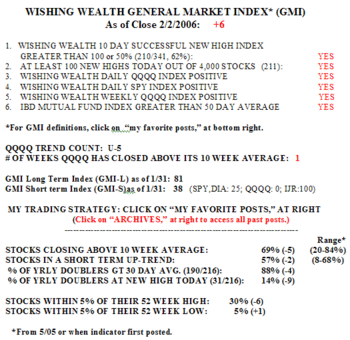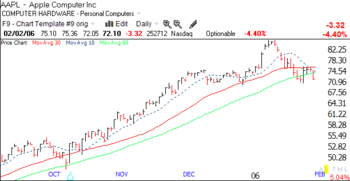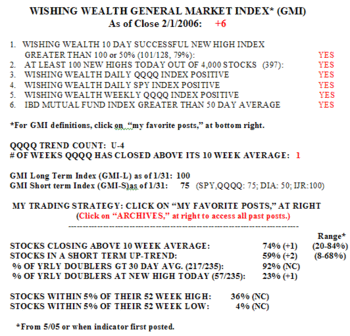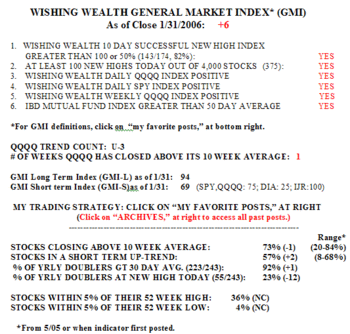While the GMI stayed at +6, my more sensitive indicator of the short term trend declined from 75 to 38. The QQQQ scored 0/4 while the SPY and DIA scored 1/4. Only the small cap index, IJR, is strong with 4/4 indexes positive.  Only 11% of the Nasdaq 100 stocks rose on Thursday, along with 21% of the S&P 500 stocks and 10% of the Dow 30 stocks. Still there were 211 new highs in my universe of 4,000 stocks and 62% of the 341 stocks that hit a new high 10 days ago closed higher on Thursday than they did 10 days ago. I consider Thursday to be the fifth day of the short term up trend in the QQQQ, but this trend is very vulnerable to a reversal……
Only 11% of the Nasdaq 100 stocks rose on Thursday, along with 21% of the S&P 500 stocks and 10% of the Dow 30 stocks. Still there were 211 new highs in my universe of 4,000 stocks and 62% of the 341 stocks that hit a new high 10 days ago closed higher on Thursday than they did 10 days ago. I consider Thursday to be the fifth day of the short term up trend in the QQQQ, but this trend is very vulnerable to a reversal……
The great traders, Darvas and O’Neil) have said that when the leaders cannot rise anymore, the rest of the market will soon decline. AAPL and GOOG have broken their up trends. For both stocks their 10 day averages are now below their 30 day averages.  Take a look at this chart of AAPL. The stock has been declining on high volume and is now below its 10 day, 30 day and 50 day averages. The chart for GOOG is much the same, except there was that huge gap down on Wednesday. And Thursday night they shot another leader, ISRG, in extended trading. These are signs of a deteriorating market. I have moved my sell stops up and am not making new purchases. The GMI-L is still strong at 81, so the longer term trend is still positive. But remember, the short term indicators necessarily reverse before the longer term indicators. With earnings season ending, there appears to be little ability to push stocks higher.
Take a look at this chart of AAPL. The stock has been declining on high volume and is now below its 10 day, 30 day and 50 day averages. The chart for GOOG is much the same, except there was that huge gap down on Wednesday. And Thursday night they shot another leader, ISRG, in extended trading. These are signs of a deteriorating market. I have moved my sell stops up and am not making new purchases. The GMI-L is still strong at 81, so the longer term trend is still positive. But remember, the short term indicators necessarily reverse before the longer term indicators. With earnings season ending, there appears to be little ability to push stocks higher.
Please send your comments to: silentknight@wishingwealthblog.com.

